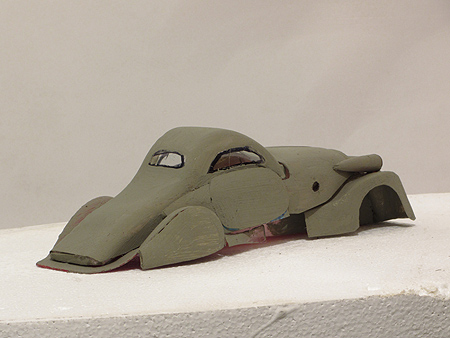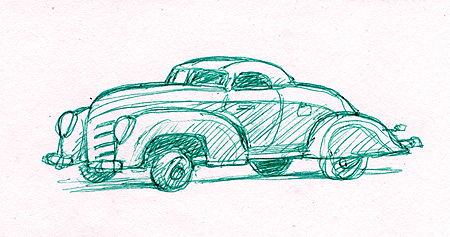|
    
Small
Cars (1)
|
|
|
Parked cars on the right side, a van
and a truck on the left. Street would
appear suspiciouisly empty without
them.
|
 |
I
was insightfull enough to predict
early enough that I'll need some
quantity of vehicles for the backgrounds,
to be parked on the streets. By
that time I knew I'll make the streets
in forced perspective, so they better
be in different sizes. I've started
to produce quite a number of different
oldtimer vehicles, in no exact size.
I believe there's thousands of car
(or truck) models around, from original
toys of the era to 3D designs. Moreover,
old cars and trucks are quite popular
in hot-rod scene, so I had to be
somewhat disciplined in my designs.
I wanted the look and the feel of
original (tin or cast, or slush,
or plastic, even wood) toys, but
of no particular design or mark,
and especially not newly made cheezy
chinese replicas. So, I started
to collect parts, mostly in plastic
(but in other materials too): this
one for the fender, that one for
the hood, and that another for the
roof. But they rarely fit together,
so I've let the parts to guide me
and used them as inspiration for
my designs. I've built and drawn
around the parts, and came to a
big number of potential models.
A number too big to produce from
start to finish every of the designs
I've put on the paper. I had to
discard similar designs in similar
sizes, so I had to enlist them on
different charts: one for cars,
one for trucks and pick-ups, another
for busses, and so on. Also, I had
to avoid similar designs in similar
paint-shemes. Hence this color-chart
of half-finished models (but "finished"
in drawing):
|
|
|
|
Above: "Tin" and "Cast"
marks reffer to what I thought the
best finish for particular design
I should atempt.
Below
left: that's how I started sorting
parts... And in the right bottom:
wheels for the big vehicles. One thing
was to collect parts and finalize
designs, even if it's only on paper.
But every vehicle needs wheels, and
it turned out that some designs didn't
have matching wheels. The biggest
trouble was, most of the trucks had
to share just one or two complets
of wheels.
|
|
|
|
|
|
|
|
|
|
|
|
|
|
|
|
|
|
|
 |
 |
|
|
|
 |
 |
|
|
|
|
|
|
|
|
|
 |
 |
|
|
|
|
|
 |
|
|
|
|
|
|
 |
 |
 |
 |
|
|
|
|
|
|
|
|
|
|
|
|
|
|
|
|
|
|
 |
|
All this cars played their part in some
shots, but I can't find any pictures
of most of them, finished and painted,
on the set. Just some of them. Untill
then, this will have to do... |
|
|
|
|
|
|
|
|
|
|
|
|
|
|
|
|
|
|
|
|
|
|
|
|
|
|
|
|
|
|
|
|
|
|
|
|
|
|
|
|
|
|
|
|
|
|
|
|
|
|
|
|
| |
| _1
The ARCTIC PIRATE index |
| _2
Color chart development, coloring and
light tests |
| _3
Storyboards, shooting plans, concept
arts, sketches |
| _4
Puppets, from sketches to animation |
| _5
Vehicles of all sorts:
5-L - Small Cars (1) |
| _6
Houses and exteriors, from sketches
to final sets |
| _7
Interiors |
| _8
Small props |
| _9
Graphics and maps for posters, banners,
press, signs etc. |
| 10
Shots against all odds |
| 11
Simple shots, confined spaces |
| 12
Basics: workbenches, tools, logistics,
etc. |
| 13
Miscellaneous |
| |
    
|